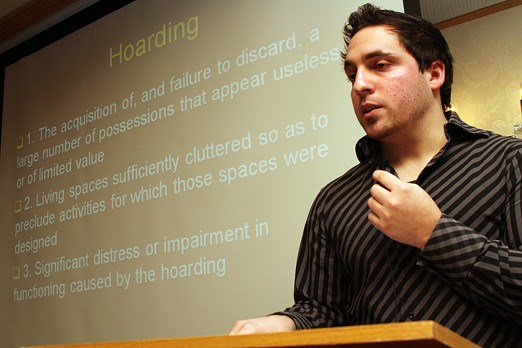Everybody poops, but most people flush it away without a thought.
But for a small segment of the population, known as hoarders, even something as disgustingly filthy as feces could have value at some point down the road.
It winds up in a box – or worse – on the floor, a sad reminder of their disintegrating psyche. Only for the hoarder, it seems normal.
It’s not easy bringing about change, said Danny Pereira, who this week introduced Hamilton’s successful Gatekeepers program to emergency, mental health and hospital officials in Thunder Bay.
“I’d be lying if I said it was easy. There’s definitely a deep-rooted reason for why they want to keep items. It does take awhile to really break through. And you may not break through,” Pereira said. “But hopefully with that rapport that you’ve built, the really hard work you’ve put in, you’re able to reason and talk with them and really educate them on the reasons why they might be keeping an item.”
In Thunder Bay, it’s a growing problem.
Ron Bourret, the city’s bylaw and enforcement manager, last week told tbnewswatch.com that compulsive collecting in the city is getting so bad in some cases people are forced to sleep outside of their homes, while others are simply trapped inside.
At times it’s proven deadly. One woman was trapped under piles of newspaper, while her home burned around her.
“We’ve gone in and there’s human excrement up to two feet on the floor. You’re walking around and you see counters where there’s animal feces everywhere. It is so bad that you don’t recognize things as furniture anymore,” Bourret said.
Another woman, who lived in a trailer, wrote the words “help me please” on her window because she needed help. In yet another incident, bylaw workers found a home filled with plastic bottles.
“Once it gets out of hand, it’s out of hand,” Bourret said, noting hoarders often have no idea the impact they’re having on the community surrounding them.
The smell from one home prevented residents in a two-block radius from enjoying summer in their backyards, he said, noting the city dealt with five serious cases of hoarding in 2011, and have already responded to a pair of serious cases in the early days of 2012.
Each case is different, Pereira said, as hoarders are afflicted at varying levels.
“Usually we go with the smaller things to get the ball really rolling. Then they can really say there may be a change around them. But when you get to that really hard item that you may not be able to get them to discard, if you’re able to get rid of one or some of them there is kind of that aha moment when you really feel you are working with them and they’re working with you,” Pereira said.
Seeing hoarders glamorized and ostracized of late on reality television has both good and bad side effects, he added.
The A&E network has been airing Hoarders since 2009, while TLC began running Hoarding: Buried Alive in March 2010.
It’s helped to bring awareness to the problem, but it’s also hurt in the sense that viewers might think a hoarder can be cured in an hour.
“It’s not that easy and you really have to build that rapport and really work with them, be client direct and let them make decisions, just set guidelines about when you’re doing it. That’s the one part that that show doesn’t really show,” Pereira said.
It’s usually a family member or a friend who seeks help for the hoarder, though often it’s police or fire officials or municipal bylaw-enforcement officers who encounter a problem and set the wheels in motion to bring in the proper authorities to fix the problem.
Capt. Terry Hanchar, a fire prevention officer with Thunder Bay Fire and Rescue Service, said his department is running into more and more hoarding situations.
Depending on the severity, the fire department may take action themselves, ordering a clean-up through inspection orders or turning to other agencies for assistances to deal with the larger problem at hand.
“Our bottom line is to make sure the person’s property, wherever they’re living … is safe for them,” Hanchar said.
They’re also looking at it from a practical standpoint, he added. Too much junk could be hazardous to fire crews, as seen in the case of the woman trapped under the newspapers.
“If a person can’t get out of their house safely and quickly when a fire breaks out, they can become trapped in their house. Also, when our fire crews enter and come across a hoarding situation, it makes it that much more difficult to get to them in a timely fashion and get them out,” Hanchar said.
Unfortunately, Bourret said, most people, unless they’ve sought help on their own, will usually go right back to hoarding after their property or home has been cleaned up.
